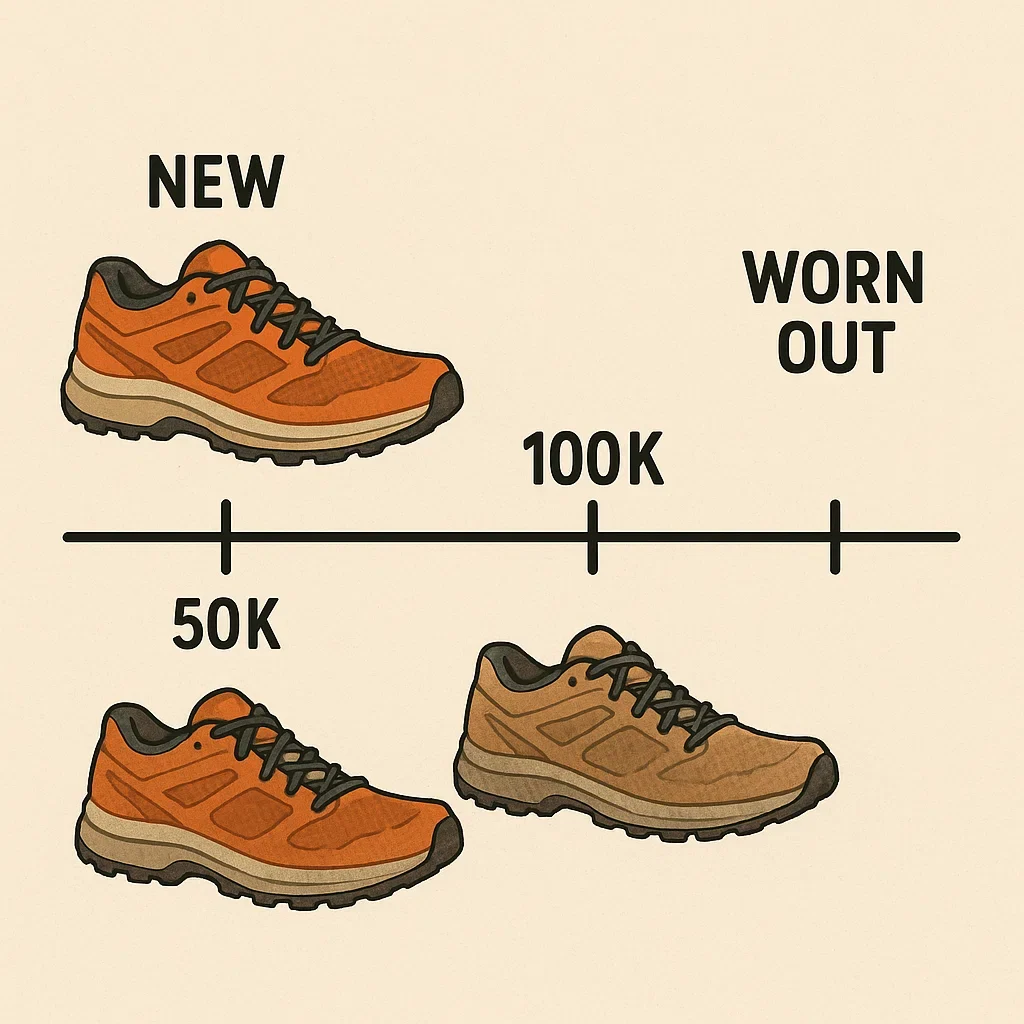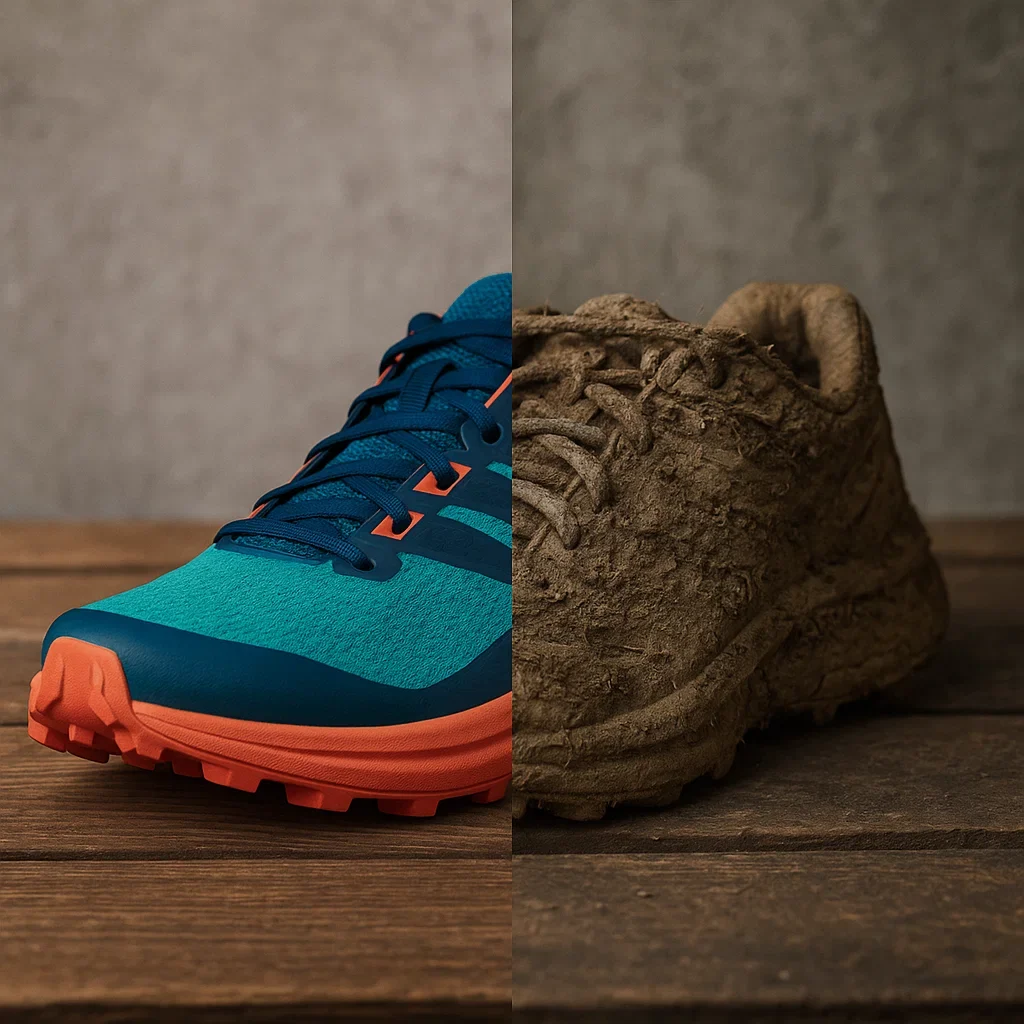🔄 Shoe Durability & Mileage for 100K Ultra Marathons – What Lasts?
You’re pushing your body to the limit over 100 kilometers of rugged, muddy, rocky, or sandy trails. But what about your shoes? How long can trail shoes truly last during a 100K ultra? It’s a question every ultra runner eventually faces, especially those training on varied terrain or aiming to finish strong without gear failures. 👣
In this guide, we’ll dive into shoe durability for 100K races, analyze expected mileage, highlight common wear patterns, and compare tested models known for surviving the long haul. Whether you’re a seasoned ultra runner or planning your first 100K, this is your essential checklist for shoe lifespan, warning signs, and smart rotation. 🏞️
🧪 What Affects Trail Shoe Durability in 100K Races?
The durability of your trail shoes over a 100K ultra isn’t just about materials — it’s a combination of factors that interact under stress, fatigue, and terrain challenges. Understanding these variables helps you make smarter buying, training, and race-day decisions. 💡
- Midsole Foam Composition: EVA, TPU, PEBA, and supercritical foams each respond differently to compression and fatigue. Some foams break down faster under sustained load.
- Outsole Rubber & Lug Design: Sticky rubber compounds offer grip but wear out faster on hard-packed terrain. Lug depth also affects longevity on technical ground.
- Upper Material: Breathable mesh may feel light but can tear easily on overgrown trails. Reinforced uppers (Matryx®, ripstop, etc.) tend to last longer.
- Runner Weight & Form: Heavier runners or those with a strong heel strike may compress midsoles faster, accelerating foam fatigue and outsole wear.
- Terrain Type: Rocky and alpine terrain can shred uppers and crush midsoles quickly. Soft forest trails are far more forgiving.
- Moisture & Mud: Wet shoes break down faster due to repeated drying cycles, bacteria build-up, and glue degradation in the midsole bond layers.
These durability-influencing factors also tie into how well a shoe performs across multiple long runs or multi-day events. Let’s now break down the actual mileage you can expect from ultra trail shoes before they start to fail. 📉
📏 Average Mileage Expectations for 100K Trail Shoes
When it comes to trail shoes for ultramarathons, most brands offer general mileage ranges — but how does that translate to a 100K ultra? And what do real runners experience during race conditions? Here’s what we’ve learned from lab tests, wear tracking, and user data. 📊
🔹 Brand Mileage Claims
- Hoka: 400–600 km (250–375 mi), depending on terrain and model (Speedgoat, Torrent, etc.)
- Salomon: 300–500 km, especially for lighter models like S/Lab Sense or Pulsar Trail
- Altra: 400–600 km, though zero-drop wear patterns may affect longevity
- La Sportiva: 500–800 km for durable, mountain-focused models like Bushido II or Akasha II
- Nike Trail: 250–450 km, depending on foam type (React vs ZoomX)
🔍 Real Runner Data
From Strava logs, Stryd power users, and ultra forums, average durability for 100K-suitable trail shoes tends to land between 350–600 km, depending on terrain and body type. Here’s a typical breakdown:
| Runner Type | Terrain | Expected Lifespan |
|---|---|---|
| Lightweight (55–65 kg) | Forest / Dirt Trail | 550–650 km |
| Average (65–75 kg) | Mixed Terrain | 400–500 km |
| Heavier (75–85+ kg) | Rocky / Technical Trail | 300–400 km |
For a 100K race, shoes need to remain structurally sound for at least 8–16 hours of continuous use. If you’re nearing the end of a shoe’s lifespan in training, it may not be worth the risk on race day. ⏳
⚠️ Signs Your Shoes Are Breaking Down (And When to Retire Them)
Running 100K in worn-out shoes is a fast track to blisters, joint pain, or a DNF. But how do you know when a shoe is truly done? Here are the warning signs you shouldn’t ignore:
- Midsole Compression Lines: Wrinkles or folds along the side foam, especially near the heel or forefoot, indicate material fatigue.
- Loss of Rebound: If your shoe feels “dead” and no longer springs back on toe-off, cushioning has likely broken down.
- Outsole Bald Spots: Smooth patches with no lug grip left reduce traction and stability on technical trails.
- Heel Collar Collapse: If the heel area gets soft or warped, your foot may slide or cause Achilles irritation.
- Visible Midsole Cracking: Cracks in the sidewalls or arch area can signal critical loss of structural integrity.
- Uneven Wear: One side of the shoe wearing faster than the other is a biomechanical red flag and injury risk.
Pro tip: If you’re unsure, compare the worn pair to a new or lightly-used version of the same model. The difference will often surprise you. 👟
🥇 Best Long-Lasting Shoes for 100K Ultra Marathons
While every foot is different, certain trail shoes have earned a reputation for surviving the demands of a 100K. These models offer a blend of durable midsoles, protective uppers, and proven outsole longevity:
- Hoka Speedgoat 5: Cushioned yet durable, with Vibram® Megagrip outsole and breathable upper redesign.
- La Sportiva Akasha II: Mountain-ready with protective overlays, dual-density cushioning, and exceptional grip.
- Altra Olympus 5: Max cushion, zero drop, and Vibram® outsole with surprising long-haul resilience.
- Topo Athletic Ultraventure 3: Wide toe box + ZipFoam™ midsole = comfort and stability over distance.
- Salomon XA Pro 3D v8: Rock-solid build with precise fit and outstanding durability on mixed terrain.
Bonus: Rotate between 2 pairs during training and save a fresh pair for race day. It’s a proven strategy for keeping your feet — and shoes — ready. 🔁
🔄 Shoe Rotation, Maintenance & Terrain Strategy
You don’t have to grind one pair of shoes into the ground. Smart runners maximize durability through conscious rotation and maintenance:
- Rotate Shoes Weekly: Use at least two pairs in training to reduce foam fatigue and allow for drying.
- Dry Naturally: Avoid heaters or dryers. Instead, stuff with newspaper and air-dry in shade after wet runs.
- Use Terrain-Specific Models: Avoid using mountain shoes on gravel roads — mismatched terrain increases wear.
- Clean Lugs & Uppers: Grit and mud buildup can speed up abrasion. A quick rinse helps extend life.
- Track Mileage: Log your shoe distances in apps like Strava, Stryd, or TrainingPeaks for replacement timing.
🏁 Final Thoughts: Don’t Let Your Shoes DNF
When it comes to shoe durability for 100K ultras, every kilometer counts. The terrain you train on, your biomechanics, and your shoe choices all influence longevity. Don’t wait for pain or failure to make a change — track your shoes, rotate smartly, and invest in models proven to go the distance. 🥾
Next, explore the advanced FAQ section and gear up with expert-backed knowledge for your ultra journey. 👇

❓ Frequently Asked Questions
👟 How many kilometers should trail shoes last during 100K training?
Most trail shoes last between 400–600 km, depending on terrain, runner weight, and midsole material. Rocky terrain and wet conditions reduce lifespan.
🔁 Should I use the same shoes for training and race day?
It’s best to train with one pair and race with a fresh or lightly-used identical model to avoid foam fatigue or hidden wear issues.
🧼 How can I clean trail shoes to extend their life?
Rinse with water, scrub gently with a soft brush, and avoid heat sources. Dry naturally with paper stuffing if wet.
📉 What happens if I run a 100K in worn-out shoes?
You risk plantar pain, joint stress, reduced grip, and higher injury risk — all of which can lead to DNF or slower finish times.
🧪 Do superfoams (like ZoomX or PEBA) last long in ultras?
They offer superior energy return but often degrade faster. Not ideal for rocky or wet ultras unless protected by tough outsoles.
⚖️ Do heavier runners wear out shoes faster?
Yes, increased load compresses foam more rapidly. Heavier runners should choose firmer or dual-density midsoles.
📏 How do I know my trail shoes are too worn for racing?
Check for midsole wrinkles, outsole bald spots, collapsed heel structure, or uneven feel during test runs.
🗻 Which models are best for rocky ultra terrain?
La Sportiva Akasha II, Salomon XA Pro 3D, and Hoka Speedgoat are popular for their rugged design and outsole grip.
🌧️ Does running in rain or mud damage shoes faster?
Yes, repeated wet-dry cycles weaken glue bonds and accelerate upper and midsole breakdown.
📲 Should I track shoe mileage manually?
Yes, or use Strava, Garmin, or Stryd to log mileage. Set a reminder at 350–450 km to start monitoring wear.
🔄 How often should I rotate trail shoes?
Ideally 2–3 times per week with at least two pairs. This allows foam recovery and extends total lifespan.
🧵 Are reinforced uppers worth the extra cost?
Yes. Matryx, ripstop mesh, or welded overlays prevent blowouts, especially on technical trails or during long races.
🔥 What’s the danger of using heat to dry trail shoes?
Direct heat can shrink glue layers, warp the midsole, and damage foam integrity. Always air dry.
👣 Do foot strike patterns affect wear?
Absolutely. Heel strikers wear rear foam faster, while forefoot strikers compress the toe box. Choose accordingly.
📦 Should I keep an extra pair of my race shoe?
Yes, especially if you love the fit. Brands change models often, and having a backup pair is smart before race day.
🔍 What’s the fastest way to test if shoes are “dead”?
Compare to a newer version of the same model, or do a short hill run — lack of bounce is an immediate red flag.
⛰️ Should I train on the same terrain I’ll race on?
Yes, both for shoe adaptation and foot preparation. Rocky training toughens both gear and gait.
🧱 Is outsole thickness or lug depth more important?
Depends on terrain. Lug depth aids grip, but outsole thickness adds wear resistance. For 100K, balance both.
🔋 Does shoe cushioning affect fatigue?
Yes. Thicker, responsive cushioning reduces joint fatigue but may trade off with stability on technical terrain.
🏷️ What if my race shoe is discontinued?
Stock up early or find a comparable model from the same brand. Use online forums to compare geometry and foam types.
📚 Further Reading

About the Author
Lost Pace is an ultramarathon runner, shoe-tester and the founder of umit.net. Based year-round in Türkiye’s rugged Kaçkar Mountains, he has logged 10,000 + km of technical trail running and completed multiple 50 K–100 K ultras.
Blending mountain grit with data, Lost analyses power (CP 300 W), HRV and nutrition to craft evidence-backed training plans. He has co-written 260 + long-form guides on footwear science, recovery and endurance nutrition, and is a regular beta-tester of AI-driven coaching tools.
When he isn’t chasing PRs or testing midsoles, you’ll find him sharing peer-reviewed research in plain English to help runners train smarter, stay healthier and finish stronger.
Ultrarunner · Data geek · Vegan athlete

